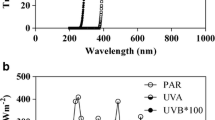Abstract.
The effect of ultraviolet radiation (UVR) and photosynthetically-active radiation (PAR) on the conversion of dissolved dimethylsulfoniopropionate (DMSPd) to dimethylsulfide (DMS) was studied in coastal, shelf and open ocean waters. Unfiltered and 0.8 μm filtered seawater samples were incubated in the dark or exposed to solar radiation for ~6 h followed by post-exposure, dark incubations with tracer additions of 35S-DMSPd. End-products resulting from 35S-DMSPd metabolism were quantified, including 35S-DMS, total volatile 35S and particle-assimilated 35S. Exposure of productive coastal and shelf waters of the Gulf of Mexico to UVR+PAR inhibited the initial rates of 35S-DMSPd consumption and the rates of 35S assimilation into cellular macromolecules by 12 to 87% and 13 to 81% respectively, compared to dark controls. After 24 h of post-exposure, dark incubation, however, the assimilation of 35S in the UVR+PAR treatments was the same as observed in dark controls. In contrast, the 35S-DMS yield from DMSPd consumption was always higher in UVR+PAR treatments than in dark controls after 24 h post-exposure, dark incubation. Exposure of mesotrophic Mediterranean Sea or oligotrophic Sargasso Sea water samples to UVR+PAR resulted in variable effects on DMS yields, with two out of four experiments showing lower, and two out of four showing higher DMS yields from 35S-DMSP compared with dark controls. In the Gulf of Mexico and Sargasso Sea, the higher 35S-DMS yields caused by UVR+PAR exposure were offset by strong inhibitory effects of UVR+PAR on 35S-DMSPd consumption rates, leading to lower 35S-DMS production overall. When DMS production from DMSPd was compared to DMS production from total DMSP, we found that only 20 to 75% of the produced DMS came from DMSPd, in one case with the lowest contributions from DMSPd in UVR+PAR treatments. Our results suggest that UVR exposure is likely an important factor promoting higher DMS yields from DMSPd in productive coastal waters, and that a substantial fraction of DMS production comes from non-DMSPd-derived sources.
Similar content being viewed by others
Author information
Authors and Affiliations
Corresponding author
Additional information
Received: 19 July 2006; revised manuscript accepted: 3 May 2007
Rights and permissions
About this article
Cite this article
Slezak, D., Kiene, R.P., Toole, D.A. et al. Effects of solar radiation on the fate of dissolved DMSP and conversion to DMS in seawater. Aquat. Sci. 69, 377–393 (2007). https://doi.org/10.1007/s00027-007-0896-z
Published:
Issue Date:
DOI: https://doi.org/10.1007/s00027-007-0896-z




